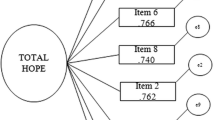Abstract
This study examined the relationships of the dispositional variables of hope, positive affectivity (PA), and negative affectivity (NA) with disease status and illness-related psychosocial functioning in a sample of 45 young adults with insulin-dependent diabetes mellitus (IDDM). Canonical analyses revealed one significant canonical function between the dispositional and psychosocial outcome variables. Primary contributors to the relationship were higher NA and lower PA and maladaptive emotional behavior. A linear multiple regression analysis using hope and affectivity as predictors failed to account for a significant proportion of variance in objective disease status as measured by hemoglobin A 1C (HbA1C). The results support previous findings that affectivity may relate to self-reported, disease-related outcome, but not necessarily to objective measures of health status. Future studies of adaptation to chronic illness should consider including measures of illness-related behaviors (e.g., adherence), as well as subjective and objective measures of health status.
Similar content being viewed by others
REFERENCES
Babyak, M. A., Snyder, C. R., & Yoshinobu, L. (1993). Psychometric properties of the Hope Scale: A confirmatory factor analysis.Journal of Research in Personality, 27, 154–169.
Bergner, M., Bobbitt, R. A., Carter, W. B., & Gilson, B. S. (1981). The Sickness Impact Profile: Development and final revision of a health status measure.Medical Care, 19, 787–805.
Clark, L. A., & Watson, D. (1991). General affective dispositions in physical and psychological health. In C. R. Snyder & D. R. Forsyth (Eds.),Handbook of social and clinical psychology: The health perspective (pp. 221–245). New York: Pergamon.
Costa, P. T., Jr., & McCrae, R. R. (1987). Neuroticism, somatic complaints, and disease: Is the bark worse than the bite?Journal of Personality, 55, 299–316.
Cox, D. J., & Gonder-Frederick, L. (1992). Major developments in behavioral diabetes research.Journal of Consulting and Clinical Psychology, 60, 628–638.
DeBruin, A. F., DeWitte, L. P., Stevens, F., & Diederiks, J. P. M. (1992). Sickness Impact Profile: The state of the art of a generic functional status measure.Social Science Medicine, 35, 1003–1014.
Delamater, A. M. (1993). Insulin-dependent diabetes mellitus.The Clinical Psychologist, 46, 198–205.
Diabetes Control and Complications Trial Research Group (1993). The effect of intensive treatment of diabetes on the development and progression of long-term complications in insulin-dependent diabetes mellitus.New England Journal of Medicine, 329, 977–986.
Dua, J. K. (1993). The role of negative affect and positive affect in stress, depression, self-esteem, assertiveness, type A behaviors, psychological health, and physical health.Genetic, Social, and General Psychology Monographs, 119, 515–552.
Dua, J. K. (1994). Comparative predictive value of attributional style, negative affect, and positive affect in predicting self-reported physical health and psychological health.Journal of Psychosomatic Research, 38, 669–680.
Elliott, T. R., Witty, T. E., Herrick, S., & Hoffman, J. T. (1991). Negotiating reality after physical loss: Hope, depression, and disability.Journal of Personality and Social Psychology, 61, 608–613.
Gilson, B. S., Gilson, J. S., Bergner, M., Bobbitt, R. A., Kressel, S., Pollard, W. E., & Vesselago, M. (1975). The Sickness Impact Profile: Development of an outcome measure of health care.American Journal of Public Health, 65, 1304–1310.
Goldstein, D. E., Little, R. R., Wiedmeyer, H.-M., England, J. D., Rohlfing, C. L., & Wilke, A. L. (1994). Is glycohemoglobin testing useful in diabetes mellitus? Lessons from the Diabetes Control and Complications Trial.Clinical Chemistry, 40, 1637–1640.
Hollingshead, A. B., & Redlich, F. C. (1958).Social class and mental illness. New York: Wiley.
Kamen-Siegel, L., Rodin, J., Seligman, M. E., & Dwyer, J. (1991). Explanatory style and cell-mediated immunity in elderly men and women.Health Psychology, 10, 229–235.
Leventhal, E. A., Hansell, S., Diefenbach, M., Leventhal, H., & Glass, D. C. (1996). Negative affect and self-report of physical symptoms: Two longitudinal studies of older adults.Health Psychology, 15, 193–199.
Niemcryk, S. J., Speers, M. A., Travis, L. B., & Gary, H. E. (1990). Psychosocial correlates of hemoglobin A1c in young adults with Type I diabetes.Journal of Psychosomatic Research, 34, 617–627.
Scheier, M. F., & Carver, C. S. (1985). Optimism, coping, and health: Assessment and implications of generalized outcome expectancies.Health Psychology, 4, 219–247.
Snyder, C. R. (1989). Reality negotiation: From excuses to hope and beyond.Journal of Social and Clinical Psychology, 8, 130–157.
Snyder, C. R. (1994).The Psychology of hope: You can get there from here. New York: Free Press.
Snyder, C. R., Harris, C., Anderson, J. R., Holleran, S. A., Irving, L. M., Sigmon, S. T., Yoshinobu, L., Gibb, J., Langelle, C., & Harney, P. (1991a). The will and the ways: Development and validation of an individual-differences measure of hope.Journal of Personality and Social Psychology, 60, 570–585.
Snyder, C. R., Irving, L. M., & Anderson, J. R. (1991b). Hope and health. In C. R. Snyder & D. R. Forsyth (Eds.),Handbook of social and clinical psychology: The health perspective (pp. 285–305). New York: Pergamon.
Taylor, S. E. (1983). Adjustment to threatening events: A theory of cognitive adaptation.American Psychologist, 38, 1161–1173.
Taylor, S. E. (1989).Positive illusions. New York: Basic Books.
Taylor, S. E., & Brown, J. D. (1988). Illusion and well-being: A social psychological perspective on mental health.Psychological Bulletin, 103, 193–210.
Taylor, S. E., Lichtman, R. R., & Wood, J. V. (1984). Attributions, beliefs about control, and adjustment to breast cancer.Journal of Personality and Social Psychology, 46, 489–502.
Watson, D. (1988). Intraindividual and interindividual analyses of positive and negative affect: Their relation to health complaints, perceived stress, and daily activities.Journal of Personality and Social Psychology, 54, 1020–1030.
Watson, D., & Clark, L. A (1984). Negative affectivity: The disposition to experience aversive emotional states.Psychological Bulletin, 96, 465–490.
Watson, D., & Pennebaker, J. W. (1989). Health complaints, stress, and distress: Exploring the central role of negative affectivity.Psychological Review, 96, 234–254.
Watson, D., Clark, L. A., & Tellegen, A. (1988). Development and validation of brief measures of positive and negative affect: The PANAS scales.Journal of Personality and Social Psychology, 54, 1063–1070.
Author information
Authors and Affiliations
Rights and permissions
About this article
Cite this article
Vieth, A.Z., Hagglund, K.J., Clay, D.L. et al. The Contribution of Hope and Affectivity to Diabetes-Related Disability: An Exploratory Study. Journal of Clinical Psychology in Medical Settings 4, 65–77 (1997). https://doi.org/10.1023/A:1026284104493
Issue Date:
DOI: https://doi.org/10.1023/A:1026284104493



